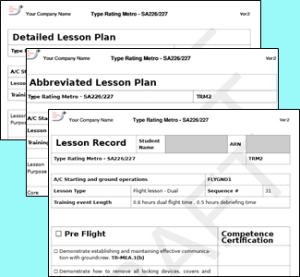We all want to produce excellent pilots from our aviation flight training programs. Pilots who are resilient, confident, knowledgeable, disciplined. Pilots who have great situational awareness, decision making skills, leadership skills, communication skills as well as excellent stick and rudder skills. The old methods of creating pilots are…well…old. Gone are the days of:
- Assuming that the Training Pilot or Flight Instructor just “knows how and what to teach”.
- Training course notes of a few pages,
- Relying on the Flight Instructor or Training pilot to remember to cover everything that is needed to be taught and assessed,
- Relying on the one word “Airmanship” as a catch all (but not really being able to explain all that this word might mean),
- Allowing one instructor to teach it his way and another to teach it her way resulting in student confusion of what is expected of them.
- Training resources (diagrams, videos etc) to be scattered in uncontrolled documents or in individual instructor’s computers.
Welcome to the Part 61 Manual of Standards with its Units, Elements, Performance Criteria and Underpinning knowledge. I’ve heard it said that the Part 61 requirements and the detail in the Performance Criteria are way too much and not necessary to teach someone to fly. Actually I believe it is that exact detail that makes for effective flight training which will produce those exceptional pilots. Good pilots pay attention to detail – and great instructors teach all the details.
“I believe it is that exact detail that makes for effective flight training which will produce those exceptional pilots.“
As course designers we need to:
- Get the correct matrix mix of what to teach and when to teach it, so we can build a course that is effective and efficient to reduce training costs, improve profits, and provide value for the pilot under training.
- Understand and be able to provide clear guidance to instructors on how to teach, demonstrate, monitor and assess the non-technical skills as well as the “Stick and rudder” skills,
- Get the components within each lesson sequenced correctly so that each learning event provides the student with an effective and efficient learning experience to make the most of the time available,
- Clearly articulate the overall goal of a course and the specific goal of each learning event,
- Describe each Performance Criteria and underpinning knowledge item in the context in which it is being presented. For example, details on how to provide a long briefing on NTS1.3 (a) “Identify problems” will be quite different to how you demonstrate that in flight and then how you, monitor, review and assess the competency standard of the pilot to “identify problems”. The use of realistic scenarios will aid this process,
- Provide adequate teaching diagrams and background articles to provide depth to the training,
- Provide clear directed private study guidance for students,
- Provide student exams to assess knowledge,
- Provide clear documented solo training lesson plans,
- Provide Detailed and Abbreviated lesson plans to provide detailed guidance to new staff and allow experienced staff to operate efficiently,
- Provide an effective Assessment Tool to assess competence and provide a Record set that tracks every PC and UPK (and the AKs when needed) to track when it was briefed, demonstrated, practiced dual and solo, examined, reviewed and assessed to competence,
- Provide a way to identify improvements in the training program to create future updates of the course material to enhance the training, and
- Provide a way to easily update the course to meet the improvement requirements of Part 141/142.
There is a lot to do to create an excellent course to produce an excellent pilot. What do you think is the hardest part in creating a Part 61 course?
Want more insight? How about a free training course on creating Part 61 Courses for Part 141 and Part 142 Training Organisations. Click the link below.
